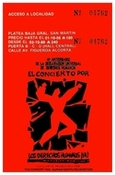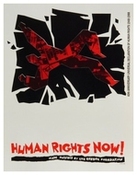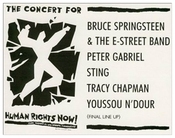
Selected Miscellaneous Shows
Oct
15
1988
Buenos Aires, AR
Human Rights Now! (Estadio River Plate)
A rousing finale to Amnesty Rights tour...
Amnesty International's Human Rights Now! tour, the most ambitious consciousness-raising caravan yet attempted by rock-and-roll musicians, pulled to a halt Saturday in Buenos Aires.
The seven-hour closing event, portions of which were broadcast live on radio around the world, marked the end of six weeks of touring designed to increase awareness of the Universal Declaration of Human Rights, adopted by the United Nations in 1948.
More than 70,000 fans at River Plate Stadium heard the touring musicians join Argentine singers Charly Garcia and Leon Gieco in 'Get Up, Stand Up,' a reggae song by Bob Marley, with the words changed to "Derechos Humanos, Ya!" (Human Rights, Now!).
Garcia and Sting, a tour performer, dedicated songs to the 1,300 people who died in the 1982 Falkland Islands conflict between Argentina and Britain.
Many in the crowd cheered as the Mothers of the Plaza de Mayo, white shawls covering their heads, marched into the stadium in a single column. The group, which holds weekly marches in a plaza facing Government House, was formed to seek after people who vanished during a military-government repression of suspected leftists in the 1970s.
Bruce Springsteen, Sting, Peter Gabriel, Youssou N'Dour and Tracy Chapman began traveling the world on Sept. 2, playing concerts in 19 cities, including Philadelphia; Paris; London; Harare, Zimbabwe; Sao Paulo, Brazil, and Mendoza, Argentina, near the Chilean border. While the artists have said that their mission - to draw attention to human rights - has generally been accomplished, they and the tour's organizer, Amnesty's Jack Healey, continue to hope that negotiations with the Soviet Union will result in a concert there before Dec. 10, Human Rights Day.The only Amnesty show in the Eastern bloc was in Budapest, Hungary, on Sept. 6.
"We're still working on it," Healey said of the Soviet show from the tour's stop in Sao Paulo last week. "We're doing all we can, and it's a situation where if they make the offer, we'll go. Right now we don't know when no is yes and yes is no. But everyone's prepared to come back to do it."
The tour covered nearly 35,000 miles, and Healey reported that the musicians were "healthy, happy, extremely cooperative" through what he considered rough traveling conditions. According to Healey, the musicians' consensus was that the concert in the Ivory Coast was the most consistently inspiring, musically. "That one was goosebumps all night long."
Also notable was the concert in Zimbabwe, attended by many South Africans. The artists addressed the issue of apartheid in speeches from the stage, and Gabriel's 'Biko', a song about slain South African activist Steven Biko, and Springsteen's version of 'War' were broadcast over radio heard in South Africa. Similarly, the concert in Mendoza was attended by many who had crossed the border from Chile, the setting of Sting's 'They Dance Alone'.
Healey also noted that as the tour progressed, the artists became increasingly involved in each other's presentations. He mentioned Chapman's cameo during the Peter Gabriel song 'Don't Give Up' as a favorite of the crew.
"It's amazing. When we're backstage and that song comes on, literally everybody working in the stadium runs back to the stage. It's like a track meet."
Seeking to quash rumors of a Sting-Springsteen feud, Healey said the relationship between the two stars was "real and honest, the best on the tour." Sting left the tour briefly at the end of September - but because of prior commitments, not a feud.
Amnesty International officials estimate that the tour, which cost nearly million, was seen by more than a million people. In addition, the human rights organization collected signatures supporting the declaration at every stop; no official tally has been released, but Amnesty expects close to a million signatures.In an effort to discourage home taping, the radio broadcast did not contain full sets from each performer. The gaps were filled with interviews and with excerpts from the 1986 Conspiracy of Hope shows.
(c) The Philadelphia Inquirer by Tom Moon
Amnesty International's Human Rights Now! tour, the most ambitious consciousness-raising caravan yet attempted by rock-and-roll musicians, pulled to a halt Saturday in Buenos Aires.
The seven-hour closing event, portions of which were broadcast live on radio around the world, marked the end of six weeks of touring designed to increase awareness of the Universal Declaration of Human Rights, adopted by the United Nations in 1948.
More than 70,000 fans at River Plate Stadium heard the touring musicians join Argentine singers Charly Garcia and Leon Gieco in 'Get Up, Stand Up,' a reggae song by Bob Marley, with the words changed to "Derechos Humanos, Ya!" (Human Rights, Now!).
Garcia and Sting, a tour performer, dedicated songs to the 1,300 people who died in the 1982 Falkland Islands conflict between Argentina and Britain.
Many in the crowd cheered as the Mothers of the Plaza de Mayo, white shawls covering their heads, marched into the stadium in a single column. The group, which holds weekly marches in a plaza facing Government House, was formed to seek after people who vanished during a military-government repression of suspected leftists in the 1970s.
Bruce Springsteen, Sting, Peter Gabriel, Youssou N'Dour and Tracy Chapman began traveling the world on Sept. 2, playing concerts in 19 cities, including Philadelphia; Paris; London; Harare, Zimbabwe; Sao Paulo, Brazil, and Mendoza, Argentina, near the Chilean border. While the artists have said that their mission - to draw attention to human rights - has generally been accomplished, they and the tour's organizer, Amnesty's Jack Healey, continue to hope that negotiations with the Soviet Union will result in a concert there before Dec. 10, Human Rights Day.The only Amnesty show in the Eastern bloc was in Budapest, Hungary, on Sept. 6.
"We're still working on it," Healey said of the Soviet show from the tour's stop in Sao Paulo last week. "We're doing all we can, and it's a situation where if they make the offer, we'll go. Right now we don't know when no is yes and yes is no. But everyone's prepared to come back to do it."
The tour covered nearly 35,000 miles, and Healey reported that the musicians were "healthy, happy, extremely cooperative" through what he considered rough traveling conditions. According to Healey, the musicians' consensus was that the concert in the Ivory Coast was the most consistently inspiring, musically. "That one was goosebumps all night long."
Also notable was the concert in Zimbabwe, attended by many South Africans. The artists addressed the issue of apartheid in speeches from the stage, and Gabriel's 'Biko', a song about slain South African activist Steven Biko, and Springsteen's version of 'War' were broadcast over radio heard in South Africa. Similarly, the concert in Mendoza was attended by many who had crossed the border from Chile, the setting of Sting's 'They Dance Alone'.
Healey also noted that as the tour progressed, the artists became increasingly involved in each other's presentations. He mentioned Chapman's cameo during the Peter Gabriel song 'Don't Give Up' as a favorite of the crew.
"It's amazing. When we're backstage and that song comes on, literally everybody working in the stadium runs back to the stage. It's like a track meet."
Seeking to quash rumors of a Sting-Springsteen feud, Healey said the relationship between the two stars was "real and honest, the best on the tour." Sting left the tour briefly at the end of September - but because of prior commitments, not a feud.
Amnesty International officials estimate that the tour, which cost nearly million, was seen by more than a million people. In addition, the human rights organization collected signatures supporting the declaration at every stop; no official tally has been released, but Amnesty expects close to a million signatures.In an effort to discourage home taping, the radio broadcast did not contain full sets from each performer. The gaps were filled with interviews and with excerpts from the 1986 Conspiracy of Hope shows.
(c) The Philadelphia Inquirer by Tom Moon






